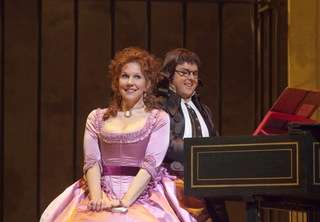|
Back
Artless Art New York
The Metropolitan Opera
10/03/2009 - & October 8, 10, 15, 24, 27, 31*, November 4, 7, 2009, February, 26, March 1, 4, 2010
Giacomo Puccini Il Barbiere di Siviglia
Joyce DiDonato (Rosina), Barry Banks (Count Almaviva), Franco Vassallo (Figaro), John Del Carlo (Dr. Bartolo), Roberto Scandiuzzi (Don Basilio), Claudia Waite (Berta), Mark Schowalter (Sergeant), Edward Parks (Fiorello), Rob Besserer (Ambrogio)
Metropolitan Opera Chorus, Donald Palumbo (Chorus Master), Metropolitan Opera Orchestra, Maurizio Benini (Conductor)
Bartlett Sher (Production), Michael Yeargan (Set Design), Catherine Zuber (Costume Design), Christopher Akerlind (Lighting Design)

J. DiDonato & B. Banks (© Ken Howard)
Il Barbiere di Siviglia was Rossini’s seventeenth opera, first performed when he was at the ripe old age of twenty-four! Although the premiere was not a success, it quickly became an audience favorite and has remained so. And why ever not? It has both wonderful tunes and irresistible characters; even the ones we don’t much like, Bartolo and Don Basilio, are drawn with compelling humanity amidst their foibles. Rossini drew his characters from commedia dell’arte, the Italian style of improvised comedy. So it’s totally in keeping that Bartlett Sher, the director of this production, has given this production a delightfully improvisatory air.
The plot is a simple one. Count Almaviva has fallen in love with Rosina, who is both Dr. Bartolo’s ward and (at least in Bartolo’s mind) his intended wife. The Count (disguised as a poor poet, Lindoro), conspires with Figaro (the barber and general man about town of Seville) to win Rosina. Almaviva masquerades as a drunken soldier in order to gain access to his beloved, and then as the replacement singing teacher for Rosina. He tells Bartolo that Don Basilio (her singing teacher) is ill. Basilio is deliciously vile, and his celebration of slander is one of the musical highpoints of the opera. Almaviva, Figaro and Rosina outwit the others. And all’s well that ends well.
Theater director Bartlett Sher’s wonderfully engaging production of Il Barbiere di Siviglia was first staged at the Metropolitan Opera in 2006. His Broadway experience and that of his team -- set designer Michael Yeargan, costume designer Catherine Zuber, and lighting designer Christopher Akerlind -- was clearly evident in his wondrously inventive staging and in his direction of his singers. They truly became a company of singing actors. Their constant comic activities – musical and also pure physical comedy – the plotting, their scheming, were all embodied in Rossini’s music.
Sher’s staging is radically simple. It’s largely a group of doors which are moved around to create interior spaces. There are also strategically placed orange trees and a long, steep stairway to Rosina’s balcony. But that’s it, really. The most innovative aspect of the staging is the extension of the stage -- called a passerelle – that projects into the audience and goes right the way round the orchestra pit. All the main characters use this walkway. And it was tremendously effective to enhance immediacy and, of course, to bring the singers into the audience. Their space became our space.
At one point, Almaviva stood on the left singing of the joys of love, while Figaro stood on the right singing of the joys of greed. At another, our Bartolo grabbed a chair, put it down on the passerelle and mulled over his problems virtually in – and to – the audience. Early on, Barry Banks actually entered through the audience. This sharing of space was fully consistent with the production’s prevailing sense of artifice. We were not in Seville; this was clearly a stage populated by singing actors.
There was no proscenium frame within which to suspend disbelief. From beginning to end, this was a work of art, not an illusion of reality. After Figaro sings his “Largo,” he bows to the audience and beckons his entourage of ladies to bow to us as well.
Joyce DiDonato must be the perfect Rosina. She sang with a gorgeous tone, melting lyricism and fabulous coloratura. Her “Una voce poca fa” was sung with utter fearlessness. Her coloratura was anchored on marvelous mellow lower notes. She has an extraordinarily flexible voice. And she is a consummate actress. The vocal fireworks never seemed applied; rather they were organic to the emotional life of her character. Rosina is in love and her coloratura has a celebratory air as the emotional expression of her joy. In the second act, when she comes to believe (wrongly) that Almaviva does not love her, DiDonato summons up real pathos.
Franco Vassallo is a marvelous Figaro – an excellent comic actor with a solid and powerful baritone voice. His Figaro is full of personality. He’s a frisky fellow, a born operator. Barry Banks as Almaviva sang ardently, with ringing high notes and a beautiful legato line. John Del Carlo’s Bartolo, while occasionally vocally challenged, did a marvelous comic turn. The audience adored him.
Roberto Scandiuzzi was an irresistibly nasty Don Basilio. The Met Orchestra, under Maurizio Benini played with sprightly grace. Neither they nor the dramatic action ever flagged.
Arlene Judith Klotzko
|